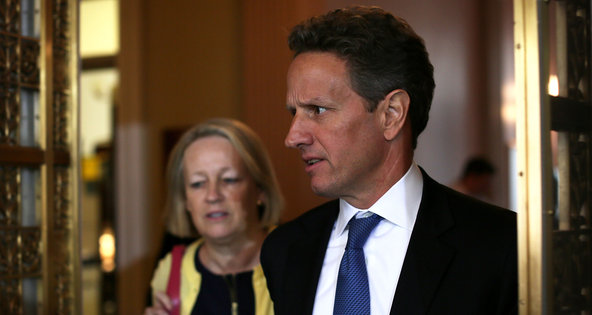 Alex Wong/Getty ImagesTimothy F. Geithner, the Treasury secretary, with Mary L. Schapiro, the Securities and Exchange Commission chairwoman.
Alex Wong/Getty ImagesTimothy F. Geithner, the Treasury secretary, with Mary L. Schapiro, the Securities and Exchange Commission chairwoman.
The biggest battles are sometimes decided by the most arcane tactics.
That could turn out to be the case in a fierce fight between the mutual fund industry and top financial regulators.
At issue is whether to impose more regulations on the nation’s $2.6 trillion of money market funds.
Regulators think the funds pose a risk to the financial system. In the 2008 financial crisis, investors fled the funds in droves, which worsened the credit freeze that gripped the banking system. Money funds then received a big bailout.
In a bid to lessen the chances of such events reoccurring, the Securities and Exchange Commission proposed measures, including requiring the money funds to hold a capital buffer against losses. But the commission dropped the reforms last week, after it became clear that a majority of its commissioners weren’t going to vote for the reforms. This was a big win for the mutual fund industry, which says some reforms made in 2010 are sufficient. The industry also argues the latest reforms would needlessly damage a popular investment product.
The regulators, however, may be able to effectively override the S.E.C. They can do that by involving the Financial Stability Oversight Council, a special committee of senior regulators set up after the crisis by the Dodd-Frank financial overhaul legislation.
The council’s job is to spot big risks in the financial system and take action to address them, even if it means acting itself or pressuring individual regulators.
After the money fund reforms were blocked at the S.E.C., much speculation began on how the council might act. At first, there appeared to be two separate paths laid out in Dodd-Frank. But both had drawbacks for the regulators.
Now, a third option may exist. And it appears to get around the headaches involved in the other two.
The council, which is chaired by the Treasury secretary, Timothy F. Geithner, and has publicly backed the S.E.C.’s money fund reforms, is scheduled to meet toward the end of September.
Initially, one of the council’s perceived options was to designate fund companies or individual money funds as systemically significant, and give them to the Federal Reserve to regulate. The problem: This approach would remove money fund regulation from the S.E.C., a potentially wrenching move that could undermine the standing of that agency. This option could also lead to a two-tier, unevenly regulated money fund sector, where larger funds might come under Fed oversight and smaller ones wouldn’t.
The second option was to declare the general activity of money market funds as risky to the system. But if this route were taken, Dodd-Frank lays out a series of steps that puts the issue back to the S.E.C., where the majority of commissioners may still oppose reform. If that happened, Dodd-Frank then appears to move the issue to Congress, but it doesn’t define how the stalemate would be broken.
Enter option three.
With this, the council would use a part of Dodd-Frank, called Title VIII, that addresses regulation of the plumbing of the financial system. It refers to “utility” activities like organizing financial payments and processing transactions.
Using Title VIII, the council could take a two-step approach. It could designate a single activity or feature of money funds as a systemically important utility function. Next, it could then require reforms to buttress that function.
For instance, money funds have a special feature called a fixed net asset value, which allows them to say each share in a fund is worth $1 when in reality it may be worth slightly less. Regulators fear the stable net asset value could mask the risks of money funds from investors, who tend to use the funds like bank accounts.
The council could designate the stable net asset value as systemic and require that the funds hold capital.
The big apparent advantage for the regulators is that it avoids the pitfalls of the other options. It would keep money fund regulation at the S.E.C. And, unlike option two, this part of Dodd-Frank doesn’t map out steps that could lead to stalemate. Instead, it allows the council to require the S.E.C. to introduce the sort of reforms that the council favors.
But there is a weakness with this approach. While this part of Dodd-Frank does give the council a lot of leeway in determining a systemically important activity, opponents of reform may argue that money funds simply aren’t part of the payment functions of the financial system, which is what title VIII was written for.
“On the face of it, this is not what Title VIII was designed to regulate,” said Jay G. Baris, a lawyer at Morrison Foerster. “To me, it’s a last resort.”
Article source: http://dealbook.nytimes.com/2012/08/30/a-third-option-for-regulators-in-the-money-market-fund-fight/?partner=rss&emc=rss